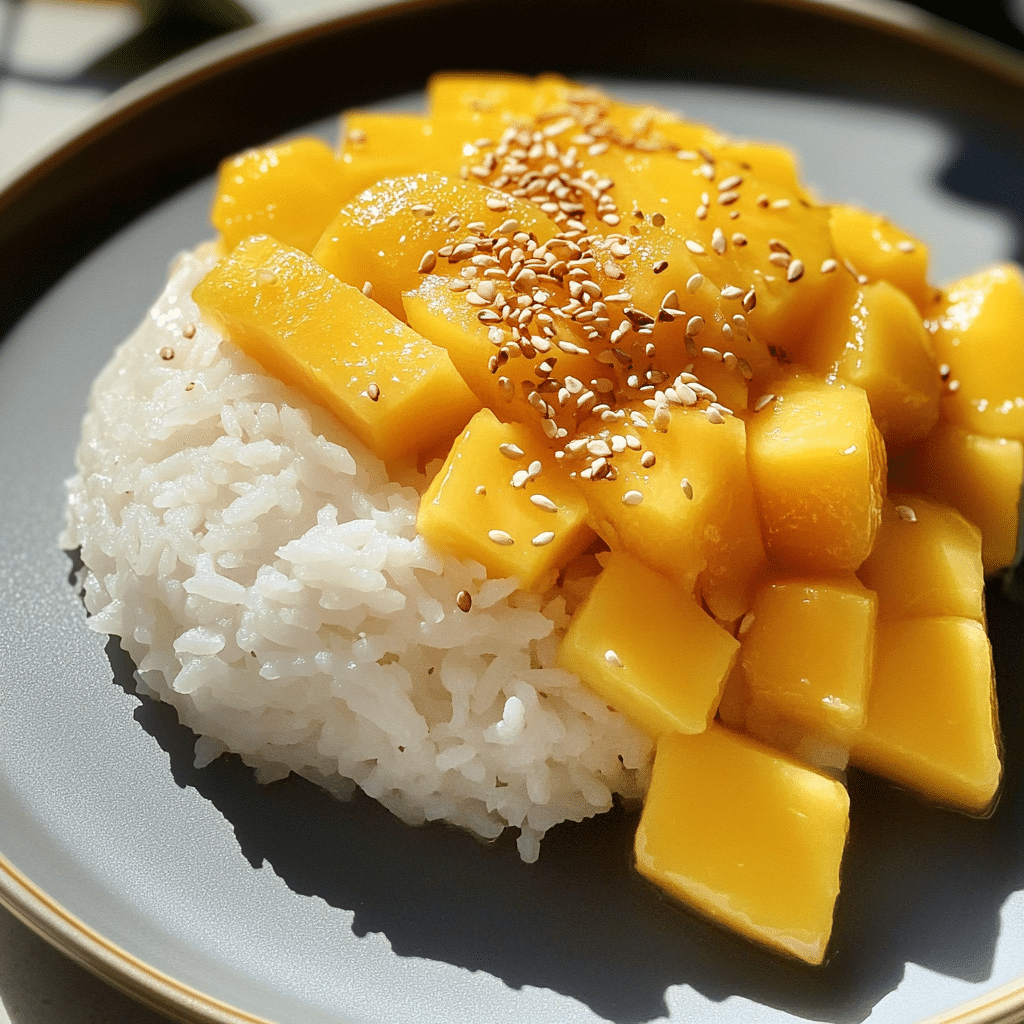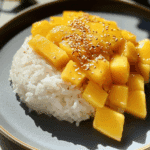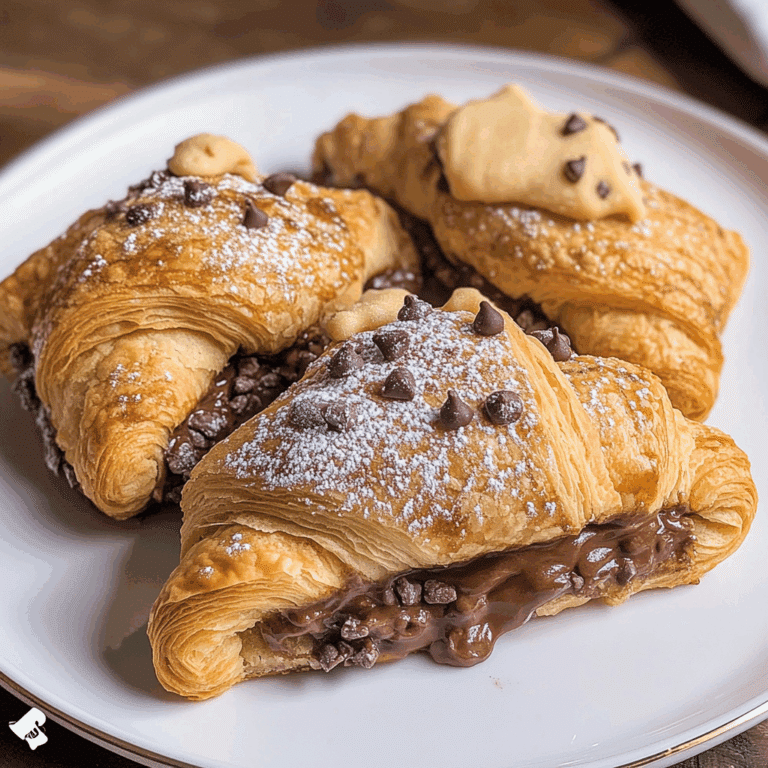How to Make Perfect Mango Sticky Rice at Home

Mango Sticky Rice is a beloved Thai dessert that perfectly balances sweet, creamy coconut sticky rice with luscious, ripe mango slices. This dish is a celebration of textures and flavors — the soft, warm rice paired with the fresh, juicy mango creates an irresistible combination that’s incredibly simple to make at home. Whether you’re craving a tropical treat or looking to impress guests with an authentic dessert, learning the secrets to making perfect Mango Sticky Rice will ensure your efforts turn out delightfully every time.
Why You’ll Love This Recipe
- Effortless Preparation: Simple ingredients and straightforward steps make it accessible, even for beginners.
- Authentic Flavor: Master the true taste of Mango Sticky Rice with traditional methods and ingredients.
- Perfect Texture: Achieve that signature creamy yet chewy sticky rice every single time.
- Tropical Delight: Fresh mango provides a natural sweetness that complements the rich coconut flavor perfectly.
- Versatile Enjoyment: Served as a dessert or snack, it fits beautifully into many occasions and meals.
Ingredients You’ll Need
Creating Mango Sticky Rice is all about the right balance of a few key ingredients. Each component plays an essential role, from the texture of the rice to the sweetness of the coconut sauce and the freshness of the mango.
- Sweet Sticky Rice (Glutinous Rice): The foundation providing that characteristic chewy and sticky texture.
- Ripe Mangoes: Choose sweet and ripe mangoes, preferably Ataulfo or Nam Dok Mai, for the best flavor.
- Coconut Milk: Adds rich creaminess and signature tropical aroma to the rice.
- Granulated Sugar: Sweetens the rice and coconut sauce to balance flavors.
- Salt: Just a pinch enhances the overall taste by balancing the sweetness.
- Optional Toasted Mung Beans or Sesame Seeds: For a delightful crunchy topping that contrasts with the soft rice.
Variations for Mango Sticky Rice
Mango Sticky Rice is wonderfully adaptable. Feel free to tweak this recipe to suit your palate or dietary preferences — the core experience remains delightfully tropical and sweet.
- Coconut Sugar Swap: Replace granulated sugar with coconut sugar for a richer, caramel-like sweetness.
- Vegan Version: Ensure coconut milk is unsweetened and substitute sugar with maple syrup or agave for a plant-based twist.
- Different Fruits: Try replacing mango with other tropical fruits such as pineapple or lychee for a unique flavor.
- Sticky Rice Cakes: Press the cooked sticky rice into molds, chill, and serve with mango slices for an elegant presentation.
- Flavor Infusion: Add pandan leaf while steaming rice for an aromatic boost.

How to Make Mango Sticky Rice
Step 1: Prepare the Sticky Rice
Begin by rinsing the glutinous rice until the water runs clear to remove excess starch. Soak the rice in water for at least 4 hours or overnight to soften the grains evenly. Drain before cooking. Steam the rice using a bamboo basket or steaming setup for about 20-25 minutes until tender but chewy.
Step 2: Cook the Coconut Sauce
While the rice steams, combine coconut milk, sugar, and salt in a saucepan. Heat gently over medium-low heat, stirring constantly until the sugar dissolves and the mixture is warm — avoid boiling. Reserve a small portion separately for serving.
Step 3: Combine Sticky Rice and Coconut Sauce
When rice is cooked, transfer it to a bowl and slowly pour the warm coconut sauce over it. Stir gently to coat the rice evenly. Cover the bowl and let it absorb the coconut milk for 20-30 minutes. This step infuses the rice with that creamy, sweet flavor Mango Sticky Rice is known for.
Step 4: Prepare the Mango
Peel and slice ripe mangoes into thin, attractive wedges. The mango should be fragrant, juicy, and firm but tender enough to bite through easily.
Step 5: Plate and Serve
Serve the sticky rice on a plate, arrange the mango slices alongside or on top, and drizzle the reserved coconut sauce over the dish. Sprinkle with toasted mung beans or sesame seeds if desired for extra texture.
Pro Tips for Making Mango Sticky Rice
- Quality Rice Matters: Use authentic glutinous sticky rice for the correct texture and flavor.
- Don’t Skip the Soaking: Soaking the rice ensures it steams evenly and achieves the right chewiness.
- Keep Coconut Milk Warm: Adding warm coconut sauce to hot rice helps it absorb better and become creamier.
- Choose Ripe Mangoes Carefully: Look for fragrant, vibrant-colored mangoes for the most delicious sweetness.
- Pandan Leaves for Aroma: Adding a pandan leaf while cooking rice can enhance the fragrance subtly.
How to Serve Mango Sticky Rice
Garnishes
Enhance presentation and taste by sprinkling toasted mung beans, sesame seeds, or shredded coconut on top. A small sprig of mint adds a fresh touch and vibrant color.
Side Dishes
Pair Mango Sticky Rice with light Thai snacks like coconut pancakes, banana fritters, or even a refreshing herbal iced tea to complement the sweetness and texture.
Creative Ways to Present
Serve Mango Sticky Rice in small coconut shells, banana leaves, or elegant dessert dishes for a tropical vibe. Layer sticky rice and mango in a glass for a stunning parfait-style presentation at dinner parties.
Make Ahead and Storage
Storing Leftovers
Store leftover Mango Sticky Rice in an airtight container in the refrigerator. Consume within 1-2 days for best freshness. Keep mango separate from rice to avoid sogginess.
Freezing
Freezing is not recommended as the texture of sticky rice changes upon thawing, often becoming hard or crumbly. For the best experience, enjoy freshly made.
Reheating
Reheat sticky rice gently by steaming or microwaving with a damp paper towel to retain moisture. Avoid overheating to maintain texture and creaminess.
FAQs
Can I use regular jasmine rice for Mango Sticky Rice?
Regular jasmine rice lacks the sticky, chewy texture required for this dessert, so it’s best to stick with glutinous (sticky) rice for authentic Mango Sticky Rice.
How do I know when the mango is ripe enough?
Ripe mangoes will have a fragrant aroma and give slightly to gentle pressure, with vibrant golden or orange skin, depending on variety.
Is Mango Sticky Rice gluten-free?
Yes, this dessert is naturally gluten-free as it uses glutinous rice, which contains no gluten despite the name “glutinous.”
Can I make Mango Sticky Rice vegan?
Absolutely! Use unsweetened coconut milk and substitute sugar with natural sweeteners like maple syrup to keep it completely plant-based.
What’s the best way to toast mung beans or sesame seeds?
Toast mung beans or sesame seeds in a dry skillet over medium heat until golden and fragrant, stirring frequently to prevent burning.
Final Thoughts
Mango Sticky Rice is more than just a dessert; it’s a delightful adventure into tropical flavors and textures that’s simple enough to master at home. By following this easy, step-by-step recipe, you’ll bring a little warmth, sweetness, and sunshine to your table — perfect for any occasion or simply to satisfy your craving for something special. So grab those mangoes and sticky rice, and enjoy the mouthwatering magic of Mango Sticky Rice today!
PrintMango Sticky Rice
Mango Sticky Rice is a classic Thai dessert that combines creamy, sweet coconut-infused glutinous rice with fresh, juicy ripe mango slices. This simple yet delicious treat balances soft, warm sticky rice and tropical mango for an authentic flavor experience that’s perfect for any occasion.
- Prep Time: 4 hours 30 minutes
- Cook Time: 25 minutes
- Total Time: 4 hours 55 minutes
- Yield: 4 servings 1x
- Category: Dessert
- Method: Steaming
- Cuisine: Thai
- Diet: Gluten Free
Ingredients
Sticky Rice
- 1 cup sweet sticky rice (glutinous rice)
- Water for soaking and steaming
Coconut Sauce
- 1 cup coconut milk
- 1/4 cup granulated sugar
- 1/4 teaspoon salt
Mango
- 2 ripe mangoes (Ataulfo or Nam Dok Mai recommended)
Optional Toppings
- 2 tablespoons toasted mung beans or sesame seeds
Instructions
- Prepare the Sticky Rice: Rinse the glutinous rice under cold water until it runs clear to remove excess starch. Soak the rice in water for at least 4 hours or overnight to soften the grains evenly. Drain the rice and steam it in a bamboo basket or suitable steaming setup for 20-25 minutes until tender but still chewy.
- Cook the Coconut Sauce: While the rice is steaming, combine the coconut milk, granulated sugar, and salt in a saucepan. Heat gently over medium-low heat, stirring constantly until the sugar dissolves and the mixture is warm but not boiling. Reserve a small portion of this sauce separately for serving.
- Combine Sticky Rice and Coconut Sauce: Transfer the cooked sticky rice into a bowl. Slowly pour the warm coconut sauce over the rice and gently stir to coat evenly. Cover and let the rice absorb the coconut milk for 20-30 minutes, enhancing its creamy, sweet flavor.
- Prepare the Mango: Peel the ripe mangoes and slice them into thin, attractive wedges. The mangoes should be juicy, fragrant, and tender enough to bite through easily.
- Plate and Serve: Serve a portion of the sticky rice on a plate, arrange the mango slices alongside or on top of the rice, and drizzle with the reserved coconut sauce. Sprinkle with toasted mung beans or sesame seeds if desired for extra texture and garnish.
Notes
- Use authentic glutinous (sticky) rice for the proper chewy texture – regular jasmine rice is not suitable.
- Soaking the rice is essential to ensure even cooking and achieve the perfect sticky consistency.
- Keep the coconut sauce warm before mixing with rice to help absorption and creaminess.
- Choose ripe, fragrant mangoes with vibrant color for the best natural sweetness and flavor.
- Optionally, add a pandan leaf while steaming the rice to impart a subtle aromatic fragrance.
- Toast mung beans or sesame seeds in a dry skillet over medium heat until golden and fragrant for the best topping.
- Store leftover mango and sticky rice separately in airtight containers and refrigerate, consuming within 1-2 days for freshness.
- Avoid freezing the sticky rice as it affects texture negatively.
- Reheat gently by steaming or microwaving with a damp towel to retain moisture without losing creaminess.
Nutrition
- Serving Size: 1 serving
- Calories: 350
- Sugar: 25g
- Sodium: 150mg
- Fat: 15g
- Saturated Fat: 13g
- Unsaturated Fat: 2g
- Trans Fat: 0g
- Carbohydrates: 50g
- Fiber: 2g
- Protein: 3g
- Cholesterol: 0mg
Keywords: Mango sticky rice, Thai dessert, coconut sticky rice, tropical dessert, glutinous rice dessert







